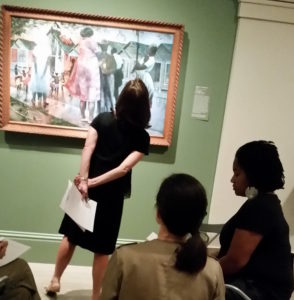Engaging the Arts and Museums with the World in Mind
A professional development and curriculum project in collaboration with Project Zero researcher Veronica Boix Mansilla, museum educators, and DC-area classroom teachers, “Engaging the Arts and Museums with the World in Mind” seeks to examine how deliberate global engagement with artworks and objects in museums can contribute to nurturing global competence among museum visitors—specifically upper elementary through high school students/educators.
Over the course of the 2016-17 academic year, the educators involved experimented with Global Thinking Routines (GTRs), developed by a team of researchers at Project Zero led by Dr. Boix Mansilla. Building on Project Zero’s long-standing traditions of promoting visible thinking and cultures of thinking, Global Thinking Routines are straightforward patterns of thought used repeatedly in a learning environment to facilitate the development of global competence among learners. In this project, the educators used the GTRs in the context of examining art and objects with a global competence goal in mind.
The project’s first iteration lasted an entire academic year, commencing with professional development seminars in which the participants explored a variety of Global Thinking Routines as they examined works of art; developed curricular units that wove in GTRs, artwork and museum visits; and culminated with the dissemination of those units.
You can find those curricular units here.


Questions that guided us throughout the year’s exploration were:
- Big picture: How can museums create powerful experiences to prepare a more globally competent public in ways that combine mindful engagement with works of art and objects while placing them in dialog with various disciplinary content?
- In museums: What might a deliberate approach to global competence development in museums look like? How might it impact museum visitors’ experiences while engaging with art and design and with the world? How might reframing collections and visits with global competence in mind influence the ways in which we view our role as educators in museums?
- In schools: How can teachers and students in formal educational settings nurture global competence through deliberate engagement with the arts and design, with museum collections, and with contemporary global issues?
- Teachers and museum educators together: What can a classroom teacher and a museum educator accomplish together that they would be unlikely to accomplish on their own? How do Global Thinking Routines work to enable us as educators in museums and classrooms to nurture global competence among visitors and students?
Over the course of the project, the project team gathered documentation (e.g. videos, blogs, student work) for the purpose of dissemination. Reflections from the educators on the learning in the seminars, as well as insights from teaching the lessons, helped us to understand the kind of learning that was taking place, the opportunities afforded, and the challenges educators may face.
Partnering schools included: Oakton High School (Fairfax County Public Schools), Sacred Heart School (Archdiocese of Washington, DC), Savoy Elementary School (DC Public Schools), School Without Walls at Francis Stevens (DC Public Schools), Sidwell Friends School (Independent), and Washington International School (Independent).
Partnering museums included: Smithsonian American Art Museum, National Museum of Asian Art (Smithsonian), National Gallery of Art, and National Portrait Gallery (Smithsonian).
This project was funded by the Longview Foundation.

A continuation of the project (also funded by the Longview Foundation) took place from February to December 2019 with Museums Go Global: Creating Exemplary Global Competence Lessons for the Smithsonian’s Learning Lab. This new iteration shifted the emphasis from visual art to all categories of museum objects but retained the focus on building global competence.